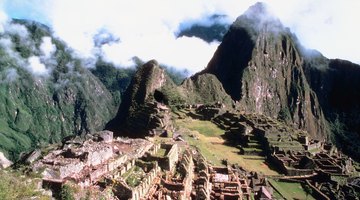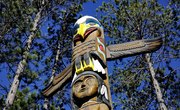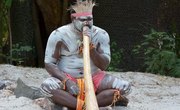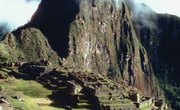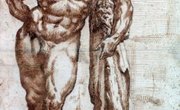The Aztecs and the Inca people developed striking civilizations -- and complex religious systems -- in very different parts of the Americas. Aztecs settled in Mexico where they placated the sun god and built pyramids. Incas erected palatial residences in the high altitudes of the Andes, read the night sky and were known as the children of the sun. Both empires were destroyed by Spanish conquistadors but left traces of their culture that tell us about their beliefs.
A Bounty of Gods
The Aztec religion was polytheistic -- they believed in many gods. One Aztec founding myth is of the goddess Omeciuatl who birthed an obsidian knife which fell to earth, shattering into 1600 gods. Huitzilopochtli, the sun, was a primary god who protected the early Aztecs as they wandered in Mexico, looking for a homeland. But the Aztecs were quick to incorporate indigenous minor gods into their pantheon. The Incas placed Initi, the sun god, in the center of their divinities, joined by Illapa, a god of the thunderbolt who rattled the heavens and sent hail, and by Viracocha who raised mountains, and created and handed down laws for humans to follow. Viracocha sculpted the first men from stone and set them underground to emerge from caves, lakes and rivers into the world.
Creation Myths
Creation, for both the Incas and the Aztecs, was a process, not a single event. Aztecs believed that there were four "suns" or eras and that each ended in catastrophe before the final, successful creation of humans. At the end of the first sun, tigers devoured the people; in the second sun, a fierce wind blew away most of the people and the survivors were turned into monkeys. In the third sun, a rain of fire destroyed humanity and those left behind became birds. At the end of the penultimate sun, a great flood washed over the earth and one man and one woman were left to repopulate the planet. Viracocha had similar challenges establishing an Inca race from clay or stone and destroying his flawed versions. There were four unlucky attempts to create humans and, eventually, one couple survived by riding out a devastating flood in a box.
Active Afterlife
Both Incas and Aztecs believed in an afterlife and developed specific practices to honor their dead. Pre-conquest Incas mummified important rulers and ancestors and kept them around -- either in their residences or in caves believed to be passageways between worlds. The mummies, easily preserved in the dry Andean climate, participated in celebratory processions, were petitioned to intercede with the weather gods, and received regular offerings of food and drink. Mummies were considered to be the actual person they were before death. Life and death were seen as an endless continuum with the soul migrating between mummified remains and carved stone effigies of the dead. Aztecs assigned the underworld several levels and a soul would arrive in one depending on its fate and occupation at death. Rulers were sometimes buried in pyramids with practical and precious grave goods, accompanied by real dogs or canine statues to help them navigate to the underworld.
Human Sacrifice
Aztec and Inca rituals included human sacrifice, in both cultures the offerings were made to seek favor from the gods. Archaeological evidence in Teotihuacan, Mexico revealed the remains of over 100 Aztec warriors buried beneath the foundations of the temple of Quetzalcoatl, most likely as guardians to safeguard the temple. Aztec priests ritually murdered sacrificial victims by cutting out their beating hearts on altars or platforms set at the tops of pyramids. The blood flowed down the pyramid steps, a striking image for the observers below and a compelling enough offering to keep the sun rising and setting each day. Inca sacrificial victims, preserved for thousands of years at the freezing tops of sacred mountains in the Andes, were typically teenagers or children. In the Inca culture, it was a supreme honor to be offered to the sun god. Some archaeologists theorize that the sacrifices of children may have been made to appease the volcanic mountains, and that the mountains themselves were considered powerful gods.
Related Articles
References
Writer Bio
Benna Crawford has been a journalist and New York-based writer since 1997. Her work has appeared in USA Today, the San Francisco Chronicle, The New York Times, and in professional journals and trade publications. Crawford has a degree in theater, is a certified Prana Yoga instructor, and writes about fitness, performing and decorative arts, culture, sports, business and education .

